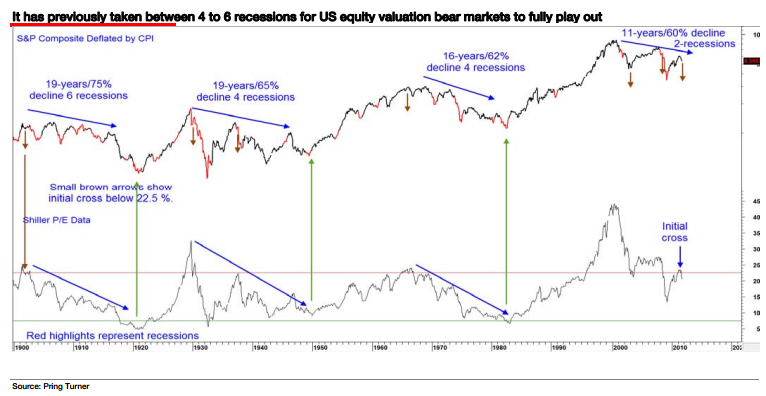Its not the end of the world folks. Headlines regarding market carnage, ridiculous bets between economists aside, you just need to print out this chart, lay it on the floor, stand on your desk and look at it:

This is the S&P Composite stock index, taken back to 1900 and deflated by CPI, correctly displayed as a semi-log chart. Below that is the Shiller price earnings or cyclically adjusted PE ratio (CAPE), which is a much more robust version of the standard 12 month forward used by most investment houses.
The chart comes from Pring Turner via Albert Edwards latest research note at SocGen who I spoke about yesterday with his ‘new GFC’ call.
Instead of Euros, dollars and Yuan, this is about understanding the bigger cycles behind stock markets. His take:
Valuation booms are followed inevitably by busts. But the key point is that these valuation bear markets take the Shiller PE back down to 7x or below.
Valuation bear markets can occur in either a high or low inflation environment but what is true for all of them is that they take many economic cycles to play out. The three previous valuation bear markets have taken between 4 to 6 recessions to fully play out (the red part of the top line are recessions).
We also know from Japans lost decade (and a half) that the process takes many economic cycles and we also know that each gut-wrenching episode of additional stock market de-rating typically occurs during recessions.
I’ve long characterised market action within secular bull and bear markets, where rallies and crashes within those dominant inclines and declines is perfectly normal and nothing to get excited about.
Edward’s call for the current secular bear market, while shocking, is not out of the ballpark of history. That some latch on to these calls as “The end of the world as we know it” as great headlines and shock jock economic wagers to the contrary shows their lack of understanding of macro itself.
Here’s Edwards final say, my emphasis added:
Since valuations peaked at the most obscene level ever in 2000, we have only seen two recessions and at the nadir of the last one, in March 2009, the Shiller PE bottomed at 13.3x, way above the typical sub-7x bottom. In valuation terms the bear market was not completed in 2009 and indeed after only two recessions there was no reason to expect it to have been completed.
If I am right and we have just seen a cyclical bull market within a secular bear market, then the next recession will spell real trouble for investors ill-prepared for equity valuations to fall to new lows. To bottom on a Shiller PE of 7x would see the S&P falling to around 550.
I will repeat that: If I am right, the S&P would fall to 550, a 75% decline from the recent 2100 peak. That obviously will be a catastrophe for the economy via the wealth effect and all the Feds QE hard work will turn dust. That is why I believe the Fed will fight the next bear market with every weapon available including deeply negative Fed Funds rates in addition to more QE.
Indeed, negative policy rates will become ubiquitous.
Indeed. Welcome to the Ice Age, or as I like to call it The Great Volatility.